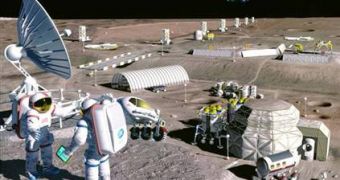Why are we so fascinated with the Moon? I mean just look around you, the universe is more than the Earth and its large satellite. Mars, Venus and Mercury are just around the corner, why are we so reluctant at sending a manned mission to any of these planets? The truth is that space missions are extremely dangerous and very expensive, that's why we prefer sending robots instead. And frankly, sending a manned mission to Mars won't make such a great difference as compared to reaching the Moon.
At least that is what professor Bernard Foing believes now. Foing, who is the executive director of the International Lunar Exploration Working Group and senior research coordinator at the European Space Agency's space science department, has developed many instruments for spacecrafts over the years and is viewed as the father of the SMART-1 mission.
"SMART-1 has shown that Europe alone can build an effective mission to the Moon. The next step is to use our expertise to develop lunar lander and rover," says Foing. The SMART-1 probe spent one and a half years orbiting around the Moon, when it collected information related to the chemical composition of the surface of the Moon, made high resolution images of possible landing sites for future lunar landers, maps of the landscape and multiple measurements in the infrared and X-ray spectrum.
"I am interested in the aspect of expanding life on other planets. For instance, looking at places where we could deploy bacteria experiments or life science experiments that could help to develop life supporting systems. In the future we would have human settlements that would grow on what we learn from life science experiments," said Foing.
Foing believes that humans would come to live on the Moon sometime in the future; however, until then it must be explored with the help of robotic missions and orbiters. Countries having different probes to the Moon could start to cooperate for sharing the information collected in their study, so that in the end life-support systems to be constructed and humans to become a permanent presence on the Moon.
"We are offering some of out SMART-1 data to help other countries to prepare their missions. With our ESA ground stations, we are helping the Chinese to double the amount of data they are going to downlink with their Chang'e 1 mission," he added.
But the Moon is not the only point of interest for Foing. As he stated, "In the case of ExoMars - expected to launch in 2013, we are going to deploy instruments that will search for signs of extinct or extant life. It has a battery of organic sensors and life search instruments. We also have a series of geophysical instruments like the camera system which I am involved with."
It is widely believed that Mars might have been habitable for the first billion years, thus the Red Planet could have had life on its surface, or maybe we are Martians ourselves and life was transported here from Mars. Evidence that life ever existed on Mars may be difficult to find, especially while considering that, for the last three billion years, the Red Planet has been less than an inhospitable place to live in. One thing is for certain though: if life didn't appear on Mars, then it could have appeared elsewhere, as there is sufficient evidence to prove that organic molecules - the building block for life - exist all over our solar system, but not only, since they have been found in other star systems and galaxies.

 14 DAY TRIAL //
14 DAY TRIAL //